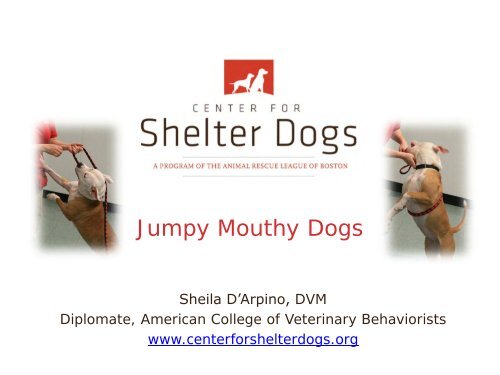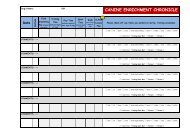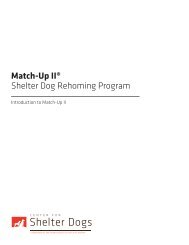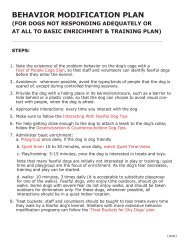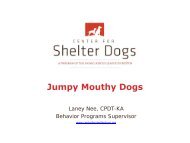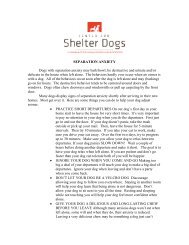Jumpy Mouthy Dogs - Center for Shelter Dogs
Jumpy Mouthy Dogs - Center for Shelter Dogs
Jumpy Mouthy Dogs - Center for Shelter Dogs
Create successful ePaper yourself
Turn your PDF publications into a flip-book with our unique Google optimized e-Paper software.
The <strong>Center</strong> <strong>for</strong> <strong>Shelter</strong> <strong>Dogs</strong>A program of the Animal Rescue League of BostonDedicated to improving the welfare of homeless dogscared <strong>for</strong> by humane organizations, animal controlfacilities, and rescue groups throughout the nationScience-based research and outcome assessment arethe cornerstones of our ef<strong>for</strong>tsWe help shelters and shelter dogs!
Key Components of Successful <strong>Shelter</strong>Behavior ProgramsBehavior EvaluationWelfarePersonality/Behavior AssessmentAssess and Provide WelfareTraining and EnrichmentHousingMaximize and Improve AdoptabilityBehavior modificationHonest, but engaging pet descriptionsFind the Right Home!Matching the pet to the right adopter/familyPost-adoption follow-up
Behavior Modification Programs and Plans?Prioritize programs and treatmentplans which will maximizeadoptions and improve welfare
What Problem Behaviors areMost Common in YOUR<strong>Shelter</strong>/Organization?
<strong>Shelter</strong> Dog NeedsBed, toys, walks <strong>for</strong> eliminationTraining: Say Please Program, sit, look,rewarding calm behaviorPlay with dogs: Doggie Social Hour (playgroups!)Play with people: Games (retrieve, nosework,etc.)Alone games: food dispensing toys, foodpuzzlesTime with people: quiet time, city walks, etcGroup housing
Goal of Behavior Modification ProgramsAssess riskDetermine responsivenessto treatmentDetermine type of adopterthat is best <strong>for</strong> petPets are usually NOT curedvia behavior modificationplans
Behavior Modification <strong>for</strong> Problem BehaviorsFocus on effective management ofproblem behaviorsBhr Mod begins with basic trainingand enrichmentCreate behavior plans <strong>for</strong> specificproblems that your shelter hasthe capacity to treat
www.center<strong>for</strong>shelterdogs.org/Home/DogBehavior/ProblemsandManagement/<strong>Jumpy</strong><strong>Mouthy</strong>.aspx
<strong>Jumpy</strong> <strong>Mouthy</strong> <strong>Dogs</strong>Dog with an energetic, playful,confident personalityPoor behavioral inhibitionNo INTENT to do harm
Pavlov/Eysenck’s Personality ModelHigh arousal, good inhibitionLow arousal, good inhibitionHigh arousal, poor inhibitionLow arousal, poor inhibition
Stimuli <strong>for</strong> the <strong>Jumpy</strong> <strong>Mouthy</strong> BehaviorANY interaction with peopleBehavior often worse after periodsof NO attentionBehavior often worse withincreased stress
Evaluation- <strong>Jumpy</strong> <strong>Mouthy</strong>
History of the JM Dog‘Dog who was never trained’
History of the JM DogDog who was trainedBut stress ofbeing in shelterand inadequateenrichmentresult infrustrationBut techniquesused didn’twork- resultedin increasedfrustrationBut VERY highenergy,impulsive dog,who hasdifficulty stayingfocused
Look at Stimuli <strong>for</strong> JM BehaviorTraining equipment being puton/off?Taking back to kennels?Longer shelter stay?
When does JM Behavior Appear?Usually 48-72 hours afteradmissionLess often at day 0
A ‘Typical’ <strong>Jumpy</strong> <strong>Mouthy</strong> Dog1.5 year mixed breed dogVery energeticGrabs onto leash and tugsJumps on people<strong>Mouthy</strong> during play***some of these dogs are VERY mouthy…i.e., grab clothing and tug at it. Keepingstaff and volunteers safe is crucial
Training Plan <strong>for</strong> <strong>Jumpy</strong> <strong>Mouthy</strong> <strong>Dogs</strong>Reward calm/ignore inappropriate behaviorSay Please programPlay with people: retrievingTeach ‘drop it’Play with dogsBasic trainingCrate trainingQuiet time
Working with <strong>Jumpy</strong> <strong>Mouthy</strong> <strong>Dogs</strong>ALWAYS have valuabletreats and toysAsk <strong>for</strong> good behaviorBEFORE ‘bad’behavior occurs
The PlanInitial training withexperienced/trained staff andvolunteers ONLY
Say Please ProgramLack of CONTROL of any aspecttheir environment is verystressful to many dogs‘Say Please’ introducesconsistencycontrolstructure
Say Please Program
Jumping up on PeopleRemember that jumping upcan be a self rewardingbehavior!!!Trainers need to increase thedog’s motivation to do what WEprefer
Play with People
Play with PeopleStarts with retrieving (if dogretrieves)Once dog retrieves well, anddrops toy easily and regularlyTeach tug and drop it (if dog tugs)
Playing the Chase Game
http://www.center<strong>for</strong>shelterdogs.org/Home/DogWelfare/Enrichment.aspx
Drop It
Playing with <strong>Dogs</strong>- Playgroups
Quiet TimeVERY important <strong>for</strong> excitable dogs
APDT’s C.L.A.S.S. ®<strong>Dogs</strong> (at our shelter) are tieredgreen, blue, or redVolunteers work on CLASS, onlywith tiers of dogs they havebeen approved <strong>for</strong>
C.L.A.S.S. ®5 lesson plans Bachelor’s degree inCLASSwww.mydoghasclass.com/students/handbook/default.aspx
Behaviors in C.L.A.S.S. ®Lesson Plan One: ‘look’ and four feet on thefloor when exiting the kennelLesson Plan Two: ‘sit’, ‘down’, ‘drop it’, andkeep four feet on the floor when greetingpeopleLesson Plan Three: loose leash walking, sitswhen asked (when playing an exciting game)Lesson Plan Four: ‘leave it’, ‘shake’, and ‘stay’Lesson Plan Five: ‘come’, settles in crate andis com<strong>for</strong>table, ‘wait’
JM Training SessionTask (15-30 minutes total)Time(minutes)RepeatIgnore JM bhr and reward calm bhr 2 to 3Play/Train 1 to 2/ 1 to 2 2 to 3 timesIgnore JM bhr and reward calm bhr 1 to 2Play/Train 1 to 2/1Crate training 2 to 3Quiet time 5 to 10
Record your Interaction!
Walking Outdoors
Reward Calm Behavior
Play/Train
Crate Training
Quiet Time
Treatment Duration/Other ConsiderationsMost dogs respond within 1-2 daysContinued treatment while the dog isin the shelter is crucialHigh likelihood of recurrence iftreatment plan isn’t continued orwith long shelter staysThese dogs are often more likely tobe returned than many other moreserious problem behaviors
AversivesWhat about using an aversive whentraining plan has failed despiteconsistent and persistent use (atleast two weeks)?Understand the risks of aversives!!
Aversives <strong>for</strong> Inappropriate BehaviorGenerally not recommended…Spray bottleShaker CanCitronella spray (SprayShield)Stern voiceRemember that some dogs areVERY sensitive to aversivesand that if they are ever used,they must be used rarely,judiciously and appropriately.
Using Aversives <strong>for</strong> Undesirable BehaviorSometimes work, otherwise peoplewouldn’t use themMay CAUSE anxiety and fear associatedwith person administering aversive.Some dogs do not respond to aversiveand might even respond to aversivewith aggression
Gentle Leader Head Collar
AdoptionThe right home is crucialActive peoplePeople who enjoytraining dogsPeople who are willingto invest time, energy,and ef<strong>for</strong>t
Post adoption support and follow-upFree counseling/trainingappointmentsPhone calls and emailsAdopter knows that we are ‘ontheir team’
A recording and all documents in this webinarwill be located at:www.center<strong>for</strong>shelterdogs.org/Home/ResearchandEducation/Webinars/tabid/113/201204/default.aspxSheila D’Arpino, DVM, DACVBsdarpino@arlboston.orgThank You!!


